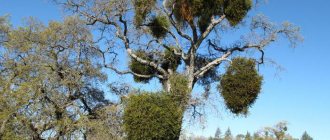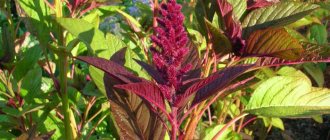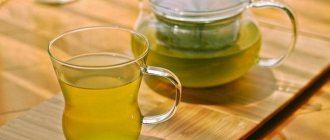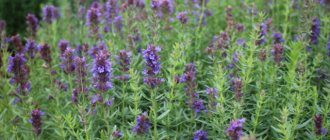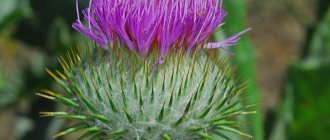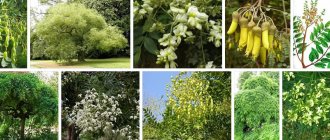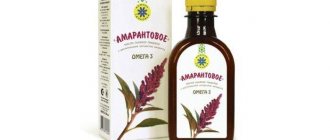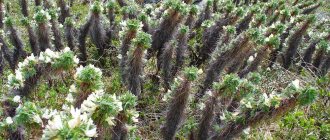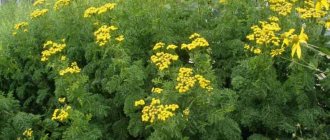Description and distribution area of acacia
North America is considered the homeland of acacia; currently the culture has been brought to Europe, Asia, Mexico, Africa, Australia and southern Russia. Flowering acacia is found along railways and highways, and as an ornamental plant in parks, squares, and gardens.
in nature there is a wide variety of acacia species, differing in botanical characteristics
Types of acacia
There are more than 500 plant species in nature, the most common of which are:
Sticky - has a specific jelly-like pubescence of shoots and pink flowers collected in an erect raceme.
New Mexican - the trunk and shoots of this species are covered with gray awl-shaped spines, the color of acacia is white or light pink.
Bristle-stemmed - characterized by the covering of all above-ground parts with red-colored bristles and flowers of purple or lilac color.
Willow - received its name for its resemblance to a weeping willow, its branches are thin and drooping.
Magnificent - distinguished by small feathery leaves and bright yellow spherical inflorescences.
Yellow acacia or caragana - blooms with yellow flowers that resemble butterflies.
Long-leaved - characterized by rapid growth and narrow, elongated leaves with a pointed end. The flowers are small, pale yellow, forming an erect raceme.
White – has the greatest healing abilities, we will talk about it in detail in this article.
white acacia is widely used in official and folk medicine
White acacia can reach 20 meters in height and has a cylindrical spreading crown with a rounded top. The root system of the plant is branched, deeply planted with nitrogen-fixing nodules. The bark of white acacia is thick, gray-brown in color with deep longitudinal cracks. The leaves are pinnately compound, consisting of 11-19 ovate small leaves. When acacia blooms, the tree is strewn with small fragrant white flowers, collected in multi-flowered inflorescences resembling drooping racemes. Blooms at the end of May, bears fruit in August - September. Acacia fruits are brown beans up to 10 cm long. The seeds are kidney-shaped, olive, dark brown, less often black, shiny or matte. The plant is a honey plant and provides nectar for bees to obtain valuable honey.
Acacia wood is used for furniture production, finishing work and making gun stocks.
Chemical composition of the plant
Acacia flowers' medicinal properties and contraindications are determined by the biologically active substances they contain:
- Flavonoids;
- Tannins;
- Glycosides;
- Vitamins A and C;
- Essential oils;
- Routine.
White acacia leaves are rich in acacetin, acetylcholine, norepinephrine and vitamins A and C. The fruits contain up to 15% fatty oil, which includes useful substances such as linalool and luteolin.
the rich chemical composition of the plant allows it to have a healing effect on the human body
The healing properties of acacia. What parts of the plant are used
Acacia exhibits beneficial properties: anti-inflammatory, antispasmodic, antipyretic, hypotensive, tonic, laxative.
The healing properties of acacia help with inflammation and pain in the stomach and intestines, gastric bleeding, food allergies, and women's diseases. Acacia flowers are used for thrombophlebitis, stomach ulcers, gastritis, rheumatism, radiculitis, neuralgia, and osteochondrosis. The inflorescences have a positive effect on colds, coughs, nervous tension, and insomnia. Acacia dilates the walls of blood vessels and accelerates the process of hematopoiesis, calms, energizes, and returns healthy, sound sleep. Acacia exhibits medicinal properties in gynecology; flowers, bark and fruits of the plant are used for these purposes.
The bark and flowers of white acacia contain a flavonoid - robinin, which is capable of removing urea from the body; it is this ability that is used by official medicine. The bark is used for diseases of the gastrointestinal tract.
Juice from acacia inflorescences is used as an antipyretic, anti-inflammatory and expectorant. The drink is used for diseases of the bladder and kidneys.
acacia honey has good taste and is a valuable medicinal product
Acacia honey is healthy; it has a delicate taste and aroma of fragrant flowers. In liquid form, the product is transparent, but during the sugaring process it becomes white. Honey is rich in glucose and fructose, useful for stomach ulcers and gastritis. The product improves digestion and heals lesions of the mucous membranes. It has a beneficial effect on the function of the cardiovascular system, normalizes blood pressure and hemoglobin levels in the blood. Improves vision, activates blood circulation, has a bactericidal effect, helps with periodontal disease, gingivitis, neurodermatitis, eczema and ulcers. Inhalations with a 30% aqueous solution of honey are effective for bronchitis, laryngitis, tracheitis, and rhinitis.
Medicinal properties and contraindications of acacia
When acacia is mentioned as a medicinal plant, they mean white robinia. Its main active ingredient is robinin glycoside. It has a hepatoprotective effect and reduces the level of nitrogenous substances in the blood during developing renal failure. More than a dozen different flavonoids have been found in the flowers of the plant, some of which are included in anti-hangover tablets.
Robinia essential oils are used in perfumery. The unripe fruits of the tree are a source of the antioxidant quercetin, and the bark contains more than 7% tannins, which are effective in the treatment of bacterial infections. When the bark is damaged, silver acacia releases gum, which consists of 76% arabana polysaccharide.
Acacia flowers are used in folk medicine due to properties such as:
- antipyretic;
- antispasmodic;
- choleretic;
- diuretic;
- astringent.
Acacia honey, almost white from Robinia and lemon yellow from Caragana receives very flattering characteristics from beekeepers, doctors and lovers. It has a restorative, sedative and antimicrobial effect when taken orally, and also heals wounds, eczema, and ulcers externally. Inhalation of an aqueous solution of honey is recommended for inflammation of the upper respiratory tract.
When using Robinia as a medicinal plant, you should remember that its seeds, bark and roots are poisonous. The root is especially dangerous because it has a similar appearance and smell to licorice. Failure to comply with dosages can lead to poisoning, accompanied by a sharp drop in blood pressure. Treatment with this plant is contraindicated for pregnant women, breastfeeding women, children under 12 years of age, and persons with individual intolerance.
Contraindications and side effects
The use of acacia must be agreed with the attending physician, who also sets the dosage and course of administration. Products containing the plant are not recommended during pregnancy and lactation, during acute exacerbations of diseases of the internal organs and digestion, or in case of individual intolerance. The bark contains a large amount of the substance toxalbuminrobin, which can lead to irritation of the mucous membrane. Take with caution to people with low blood pressure and low acidity of gastric juice. In case of overdose, side effects may occur in the form of abdominal pain, nausea, vomiting, and dizziness.
Traditional medicine considers various recipes for preparing medicinal products with acacia
Useful properties of acacia
The herbal part has:
- diuretic, choleretic effect on the body,
- antispasmodic,
- antipyretic,
- painkillers (external use of drugs),
- anti-inflammatory,
- bactericidal,
- hemostatic effect.
Bark , young tree branches have the following properties:
- reduce stomach acidity,
- mild laxative effect.
White acacia honey has many beneficial properties, and allergies and individual intolerance may be contraindications for its use.
- Useful for strengthening the immune system.
- Stimulates the functioning of the intestinal tract.
- It has an antiseptic effect for colds and is used externally to treat wounds.
- Improves skin condition (masks, lotions).
- Honey solution is instilled into the eyes when cataracts or conjunctivitis appear.
Traditional medicine recipes based on acacia
To prepare medicinal products, flowers, leaves, as well as acacia pods and bark are used, from which essential oil is extracted. Acacia is used in folk medicine in the form of teas, infusions, decoctions and tinctures. Medicinal products are used for both external and internal use.
For colds and coughs, add 1 tbsp. l. 250 ml of dry petals are added. boiling water, infuse and take with honey until complete recovery.
Tea made from 1 tbsp will help with whooping cough. l. dried crushed flowers brewed in milk or water. The infused and strained drink is taken with honey.
For diseases of the oral cavity, use an infusion of 1 tbsp. l. dried flowers and a glass of boiling water. Infuse, filter and use for rinsing.
For stomatitis, prepare a remedy containing 1 tsp. acacia honey, 1 tsp. baking soda and a glass of water. Rinse with healing liquid, combining with resorption of 1 tsp. acacia honey.
For gastritis and ulcers, use a decoction of the bark: 1/2 tbsp. l. crushed raw materials are placed in a container with 1/2 liters of water and boiled over low heat for 20 minutes. Strain and consume, adding water for 2 weeks.
For stomach ulcers, a vodka tincture prepared according to the recipe will help: 2 tbsp. l. Grind the bark, pour in 0.6 l. alcohol-containing liquid. Place in a dark place to infuse, during which the contents should be shaken periodically, and strain after 10 days. Take white acacia tincture half an hour before meals, 20 drops three times a day.
For diseases of the kidneys and genitourinary system, the following recipes are used:
- Art. l. The inflorescences of the plant are combined with a glass of boiling water and left for 30 minutes. Strain and take 100 ml. after every meal.
- Art. l. flowers and 1/2 liters of water at a low boil for 3 minutes. The infused mixture is filtered and taken in small portions before meals.
Acacia flowers help in the treatment of diseases of the musculoskeletal system and skin pathologies
For external use, an acacia tincture is prepared: the container is filled with inflorescences to 1/3 of the volume, alcohol is added to the top. Seal tightly and put in a dark place to infuse, remembering to shake the contents periodically. After 2 weeks, filter and use for rubbing for rheumatism, radiculitis, varicose veins.
With tired legs and spider veins, a tincture of 100 g helps. inflorescences and half a liter of vodka. The mixture is infused in a dark place for 2-3 weeks, crushed lemon is added and infused for another 7 days. The finished tincture is filtered and used for rubbing the affected areas before bed.
Acacia flowers are used in gynecology; for inflammation and leucorrhoea, a tincture is used: 200 g. raw materials are poured with 1/2 liter of vodka, infused in a dark place for 2 weeks. Strain and take 1 tsp. (for older women and girls) and 1 tbsp. l. (for young women) half an hour before meals three times a day.
For inflammation of the ovaries, appendages and uterine fibroids, 1 tbsp. l. 200 ml of dried flowers are steamed. boiling water, leave for 15-20 minutes. The strained infusion is taken in 2 tbsp. l. three times a day half an hour before meals for 2 weeks.
A decoction of the leaves is used as an anti-inflammatory and antipyretic agent: 1 tbsp. l. dry raw materials with a glass of water are boiled over low heat for 5 minutes. Infuse, filter and drink according to Art. l. three times a day before meals.
White acacia essential oil has a calming and relaxing effect on the human nervous system
Acacia essential oil in aromatherapy
White acacia is used in aromatherapy; its aroma has a relaxing and calming effect. Essential oil helps with:
- nervous overstrain and increased excitability;
- nervous exhaustion, depression, overwork;
- headache, insomnia;
- menopause and premenstrual syndrome;
- frigidity.
To eliminate these unpleasant symptoms, you need to put 1-2 drops of acacia ether into an aroma lamp and inhale the healing vapors.
The use of acacia in cosmetology
White acacia exhibits medicinal properties in cosmetology; it is indicated for all skin types, especially effective for problematic, sensitive, dehydrated and aging skin. The plant tones, increases elasticity, regenerates, eliminates wrinkles; daily use in skin care increases its elasticity and has a rejuvenating effect.
white acacia has a beneficial effect on women's health and beauty
A mask for oily skin is prepared according to the recipe: 1 tbsp. l. mix acacia leaves with whipped egg white and 1 tsp. skim milk. Apply to face and rinse with warm water after 15-20 minutes.
Mask for dry skin: to prepare it, grind acacia flowers in the amount of 10 pieces, add tbsp. l. honey and tsp. cream. Apply to facial skin, hold for 15 minutes, rinse with warm water or green tea.
A mask for normal skin is prepared from 10 crushed flowers, 1 tbsp. l. honey and 1 tsp. sour cream. The mixed product is applied to the face, kept for 20 minutes, and washed off with a decoction of acacia inflorescences.
An anti-wrinkle mask is prepared from 10 crushed flowers, 1 tsp. sour cream and 1 tsp. wheat germ oils. The mixed product is applied to the face, left for 10-15 minutes, and washed off with warm water.
A decoction of flowers is good for washing, wrapping and rinsing hair.
Collection, preparation and storage of medicinal raw materials
Acacia flowers are harvested at the beginning of their blooming, the buds are collected and dried under natural conditions, spread out in a thin layer in a well-ventilated place inaccessible to sunlight. Acacia leaves and bark are harvested in the summer, the bark is cut into thin strips and dried in an oven or electric dryer at a temperature not exceeding 50 degrees. Finished raw materials are stored in fabric or paper packaging. Flowers retain medicinal properties for a year, leaves are stored for two years, and bark for up to 3 years.
acacia is an ornamental plant and is used to decorate parks and gardens
Acacia: medicinal properties and contraindications
The famous umbrella trees growing in the haze of the African savanna are representatives of the large Acacia genus, belonging to the Legume family. In countries further north, they have relatives with luxurious foliage, interesting wood and decorative inflorescences. This article will help you understand what different types of acacias look like, how they reproduce, when they bloom, and what medicinal properties they have.
Growing acacia
The plant is thermophilic, loves sandy and sandy-clayey soil with a high content of lime, not waterlogged. It does not root well by cuttings; propagation by seeds is an effective way. Acacia seeds in a sieve are doused with boiling water twice, then soaked in warm water for 48 hours, after which they are planted in prepared boxes with soil. After germination and growth, they are transplanted into separate pots. During the first winter, the sprouts are kept in the house, and in the summer they are planted in the ground and watered well.
What does acacia look like and where does it grow?
Acacia is a genus of plants in the Legume family. Found in Africa, Australia, Mexico, Europe and Asia. It looks like a shrub or tree up to 25 m high. It is a fast-growing tree that is drought-resistant. It is planted for decorative purposes and to create protective forest plantations.
White acacia is mistakenly called another plant - Robinia. It belongs to the genus Robinia and comes from North America. It has been grown in Europe since the 18th century. The tree prefers moist calcareous soils, has a strong root system and grows quickly.
